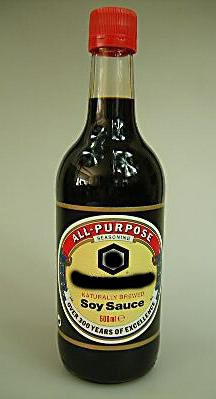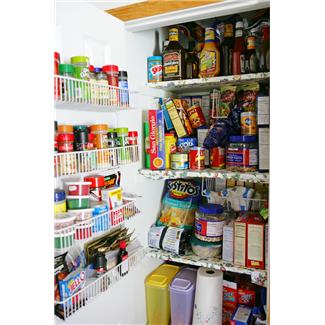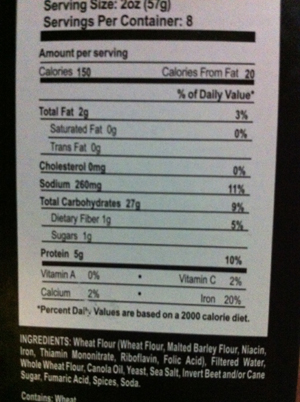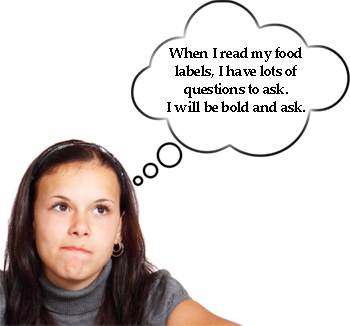Reading Food And Supplement Labels: How Habits Form
READING FOOD AND SUPPLEMENT LABELS: HOW HABITS FORM (ISSUE 91)
By Diane Gold
When we read food and supplement labels, habits form. We become more aware of what we are putting into our body. Or do we?
 There are so many ingredients in one product that the habit of reading labels must go along with doing research on what we read, if we wish to understand them. I have been studying labeling of foods since the mid-1970s when I began studying a philosophy that includes meditation (sound yoga) , a lacto-ovo-vegetarian diet and a good clean moral life. I read every label and contacted every manufacturer of anything I ate or drank, and I would pass that info on to my fellow philosophers. My purpose was to eliminate meat, fish, poultry from the diet. I was surprised at how many ingredients and processes were withheld from the consumer. Not enough has changed since then.
There are so many ingredients in one product that the habit of reading labels must go along with doing research on what we read, if we wish to understand them. I have been studying labeling of foods since the mid-1970s when I began studying a philosophy that includes meditation (sound yoga) , a lacto-ovo-vegetarian diet and a good clean moral life. I read every label and contacted every manufacturer of anything I ate or drank, and I would pass that info on to my fellow philosophers. My purpose was to eliminate meat, fish, poultry from the diet. I was surprised at how many ingredients and processes were withheld from the consumer. Not enough has changed since then.
FTC
I recently called the FTC (Federal Trade Commission) to question the wording on a label. I was excruciatingly shocked to find out that the “FTC can advocate on our behalf only if there is a pattern of abuse, rather than a single incident,” which means they cannot help us if we, as individuals, or people fewer than a group action find something wrong. The FTC looks for patterns of wrong doings. So, individual reports of inaccuracies remain unchanged.
This meant that the dietary supplements I called about did not fall under the purview of the FDA (Food And Drug Administration) that does not oversee dietary supplements, and I, alone, was not quantity enough to be heard by the FTC. So, nothing got done, and the product I called about continues to have an inaccurate label, since the FDA doesn’t regulate supplements and the FTC doesn’t regulate single complaints.
This is one of the many ways that the labeling system needs improvement.
THE SOURCE
What is also quite surprising to some is that manufacturers do not have to disclose what an ingredient is made from, as long as they acknowledge it exists in the product and someone, somewhere has tested it and it is GRAS (generally recognized as safe by the FDA).
WHAT THIS MEANS
Any ingredient whose source could be from animal, plant, synthetic sources might be from any of those sources at any time, the label does not specify. When a company discloses the source of each ingredient, it is showing respect to the consumer, in my opinion, and doing what all companies should be required to do.
 Example One: Take the alcohol in the common soy sauce, for example. It can be made from animal fat, plant substance or it can be man-made. If we choose to stay away from animal products, we won’t know whether there is animal in it by the ingredient name only. If we have an allergy to certain plants, we may not even know we are ingesting the allergic substance due to incomplete labeling practices. And, then there’s synthetic alcohol. That leaves the ingredient “alcohol” open to any number of methods of alcohol preparation.
Example One: Take the alcohol in the common soy sauce, for example. It can be made from animal fat, plant substance or it can be man-made. If we choose to stay away from animal products, we won’t know whether there is animal in it by the ingredient name only. If we have an allergy to certain plants, we may not even know we are ingesting the allergic substance due to incomplete labeling practices. And, then there’s synthetic alcohol. That leaves the ingredient “alcohol” open to any number of methods of alcohol preparation.
Example Two: Let’s look at companies that use lecithin, enzymes, mono and diglycerides, L-cysteine without identifying whether these come from animal, plant or synthetic sources. With these types of labeling techniques, much information is left out. In the case of soy lecithin, if all companies are not required to disclose genetic modified seeds, the ingredient easily can be made from modified seeds.
THE HABITS THAT FORM
 Aside from the fact that we have been raised to buy food products in packages, the labels of those products don’t tell us the source, and the materials used in the manufacturing process are not required to be disclosed. We accept this and make it a standard in our buying habits.
Aside from the fact that we have been raised to buy food products in packages, the labels of those products don’t tell us the source, and the materials used in the manufacturing process are not required to be disclosed. We accept this and make it a standard in our buying habits.
We have been raised with produce that is waxed. There is no requirement for disclosure of this process, nor is there a mandate to tell us whether the wax is petroleum-based, animal, bee or plant-based, all for the purpose of maintaining moisture and eye appeal.
We have been raised not to expect ingredient labels on household products, paints and adhesives. This means that the fact that almost all our paper bags are glued with animal parts is not labeled as well as what is in the paint on our walls, the adhesive for our plumbing.
We have developed the habit of cheering when labels must disclose something additional, such as whether something is GMO-free (whether a product contains genetically modified organisms) or not. Shouldn’t disclosure be the norm and not the exception?
TO SUMMARIZE
 1) We accept an incomplete labeling system.
1) We accept an incomplete labeling system.
2) We buy items that do not identify the source of ingredients.
3) We buy items without knowing the ingredients used in manufacturing, processing or preparing, both in produce and packaged goods.
4) Because we get a certain amount of information, we don’t ask manufacturers for more specific labeling.
 5) When we do call a manufacturer and talk to the customer service rep, we accept what these reps tell us with no written proof.
5) When we do call a manufacturer and talk to the customer service rep, we accept what these reps tell us with no written proof.
6) When we call a manufacturer and talk to the customer service rep about ingredients, we accept it when they say they don’t have any further information.
7) We accept that manufacturers, in general, do not have written agreements with their suppliers to get ingredients from specific types of sources, that is, animal, plant, synthetic, organic.
ACTION STEPS
In order to upgrade the way that we eat, research and show respect to ourselves, here are some action steps to change habits that will be of permanent benefit to the way that we eat, feel and read labels. Check these out:
1) Read labels and notice all the habits that you have regarding them. This noticing may be done over a period of time.
 2) Write down what you would require in a food, supplement or drink label to have, either to yourself or by commenting on the website.
2) Write down what you would require in a food, supplement or drink label to have, either to yourself or by commenting on the website.
3) Ask your grocers lots of questions about their wares, and be gracious about saying that you will wait for an answer. When the grocers say they don’t know and ask that you call the corporate headquarters of the store you frequent, call the corporate entity, get the name of the reps you speak with and notice how long it takes someone to call you back, or if you get a call back at all. Notice whether the answer they give is complete.
4) Ask questions of your fruit and vegetable managers. Then follow the steps in 3).
5) If you are very inspired, write a note to your local newspaper reporting your experience about how knowledgeable your local grocers and fruit and vegetable managers are. The more people talk about the topic, the more quickly we shake our old habits. The more we share our interest in this topic, the more responsible the entire chain of people involved will become.
6) Talk to friends about labels. Remember not to go on a complaint fest. But, do inform them of your inspiration to be accountable and help others be accountable by requesting food and supplements whose labels disclose and whose ingredients disclose sources.
CONCLUSION
Now that we have looked at some of the habits that reading labels develops, it is easier to change them.
Back in the 1970s, we learned about “subliminal seduction” in psychology class. This refers to any media that lures us into doing a certain behavior or thinking a certain way through repetition of words, audio or visual cues. According to University of Michigan, this mind-persuading data began in the 5th Century, B.C.
When we read food and supplement labels, let’s be diligent and live by what we find. If we don’t know someone’s name, we ask. In the same way, when we don’t know an ingredient, we can ask. This way, reading food and supplement labels will begin forming the habits that are right.
____________________________________________________________________
FEEDBACK
Please leave a comment and LIKE.
DIANE GOLD, AUTHOR
Diane Gold, Founder of Warriors of Weight, Turning Habits Into Health, is a mentor in tai chi, kung fu and meditation, a music, fitness and stress expert, dedicated mom, studying plant-based nutrition and habit change.
She has studied the labeling system since the mid-1970s. She says,
“The more we list on a label, the more testing and accountability is required by the food producer or manufacturer. The label size has to grow to fit the information on it. This is an excuse many producers give for not supporting full disclosure of their product. Many also hide behind the “proprietary ingredients” banner when it does not apply.
“It’s my hope that there will come a time when every ingredient’s source will be listed on every label and that suppliers of ingredients will be required to certify said source, that the term “natural” shall be removed from labels so that consumers are not duped and that nutritional data listed on labels shall identify which company measured it and the last date of measurement.
“I would have all produce wax labeled with wax source, any type of pasteurization process such as the steaming of raw almonds revealed on the label. I’d even require farmers to divulge which animal products, unprocessed chemicals they put in their soil during the cultivation of their food and whether they use GMO seeds. I don’t know would no longer be an acceptable answer from anyone in the industry.
“It is my mission to encourage people to be more demanding of the information they receive about their food. Until the labeling system is truly upgraded, be bold, ask questions, do research. And let the habits we form from reading food and supplement labels be those that support our lives.







